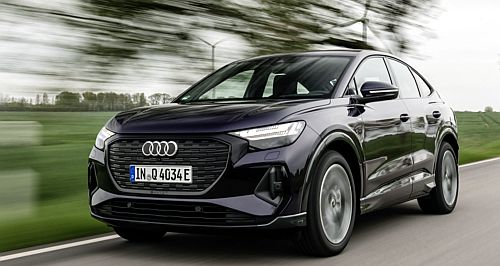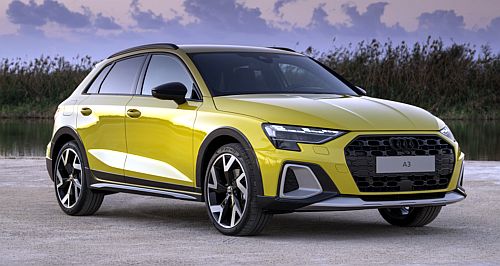Future models - AudiAudi to stay the course with BEV roll-out……with PHEVs to become an increasingly important part of the importer’s mainstream model mix6 Jun 2024 By MATT BROGAN AUDI Australia director Jeff Mannering says the German prestige importer is considering the broadening of its plug-in hybrid electric vehicle (PHEV) offerings as it seeks to balance the emissions output of cars across its internal combustion, electrified, and battery electric ranges.
Speaking with GoAuto at the launch of the new Audi Q8 e-tron and SQ8 e-tron in Melbourne, Mr Mannering said the introduction of battery electric (e-tron) models will continue as planned, with markets including Australia to consider PHEVs where such opportunities exist.
“From a global point of view, Audi is still saying that from 2026-27 there will be no more development of ICE motors,” he stated.
“That doesn’t mean we stop selling ICE models then – they will continue through their various product cycles. But it does mean that from 2033 there will probably be only new electric cars. That hasn’t really changed from a global point of view.
“In Australia, I think we’ve just become a little more complicated – and I think in a good way because of NVES (the New Vehicle Efficiency Standard) – that is not just an Audi issue, it’s a whole-of-industry issue.”
Locally, Mr Mannering said Audi will seek to balance available offerings to ensure customer needs are fulfilled while at the same time ensuring compliance with NVES legislation, which comes in to full effect from 1 July 2025.
“At the moment, every OEM has vehicles that are above the emissions cut-off, including us. But we have the Q4 e-tron coming (pictured), the Q8 e-tron, and the e-tron GT – and that’s just the start. Audi has a lot of cars that will help to offset the ICE cars that we sell,” he explained.
“The other thing that we can do, in segments where we don’t have plug-in hybrids (PHEVs) currently, such as with the current A3, is to seriously look at offering a PHEV in the new range, which isn’t too far away.
“It probably won’t be a range-topping model, but it might replace our most inefficient engine, depending of course on the CO2 output, and the price position.”
Mr Mannering said the introduction of NVES has created complexities which some OEMs may struggle to address, but believes Audi has sufficient scope within its range to comfortably balance the offerings made to Australian customers while simultaneously delivering a complaint range.
“We have to remain focused on how many vehicles we can sell. We also don’t want to make the range more complex, we want to rationalise it; and PHEVs play an important part of that process,” he added.
“Of course, we also have to first look at the price difference, the performance difference, the options available, and the profitability of the car. Every car comes with that challenge and has the potential to change what you (as an OEM) do.
“You have to look at every engine that you have in your line-up … it’s a very big balancing act. But at the end of the day, I agree with NVES. I encourage it. It may make our job a little more complicated, but it’s a really good refresher for the industry as a whole to do better.”  Read more24th of May 2024  Audi Q3 and Q5 Dynamic Black editions returnFour Dynamic Black editions are now available across the Audi Q3 and Q5 ranges, from $61,10020th of May 2024  Audi RS Q3 up for grabs in fundraiserDesirable limited edition RS Q3 Sportback to benefit Audi Foundation charities25th of April 2024  Audi Q6L e-tron revealed in ChinaLong distance battery electric Q6 e-tron a Chinese market-only SUV unveiled in BeijingAll future models Alfa Romeo Alfa Romeo Abarth Abarth Audi Audi Aston Martin Aston Martin BMW BMW Bentley Bentley Chrysler Chrysler Chevrolet Chevrolet Dodge Dodge Citroen Citroen Ferrari Ferrari DS DS Ford Ford Fiat Fiat FPV FPV Foton Foton Haval Haval Great Wall Great Wall Honda Honda Holden Holden Hyundai Hyundai HSV HSV Isuzu Isuzu Infiniti Infiniti Jeep Jeep Jaguar Jaguar Lamborghini Lamborghini Kia Kia Lexus Lexus Land Rover Land Rover Mazda Mazda Maserati Maserati Mercedes-Benz Mercedes-Benz McLaren McLaren Mini Mini Nissan Nissan Mitsubishi Mitsubishi Peugeot Peugeot Opel Opel Proton Proton Porsche Porsche Renault Renault Ram Ram Saab Saab Rolls-Royce Rolls-Royce Smart Smart Skoda Skoda Subaru Subaru SsangYong SsangYong Tesla Tesla Suzuki Suzuki Toyota Toyota Volvo VolvoMotor industry news |
Click to shareAudi modelsResearch Audi All future models Alfa Romeo Alfa Romeo Abarth Abarth Audi Audi Aston Martin Aston Martin BMW BMW Bentley Bentley Chrysler Chrysler Chevrolet Chevrolet Dodge Dodge Citroen Citroen Ferrari Ferrari DS DS Ford Ford Fiat Fiat FPV FPV Foton Foton Haval Haval Great Wall Great Wall Honda Honda Holden Holden Hyundai Hyundai HSV HSV Isuzu Isuzu Infiniti Infiniti Jeep Jeep Jaguar Jaguar Lamborghini Lamborghini Kia Kia Lexus Lexus Land Rover Land Rover Mazda Mazda Maserati Maserati Mercedes-Benz Mercedes-Benz McLaren McLaren Mini Mini Nissan Nissan Mitsubishi Mitsubishi Peugeot Peugeot Opel Opel Proton Proton Porsche Porsche Renault Renault Ram Ram Saab Saab Rolls-Royce Rolls-Royce Smart Smart Skoda Skoda Subaru Subaru SsangYong SsangYong Tesla Tesla Suzuki Suzuki Toyota Toyota Volvo VolvoMotor industry news |
















Facebook Twitter Instagram